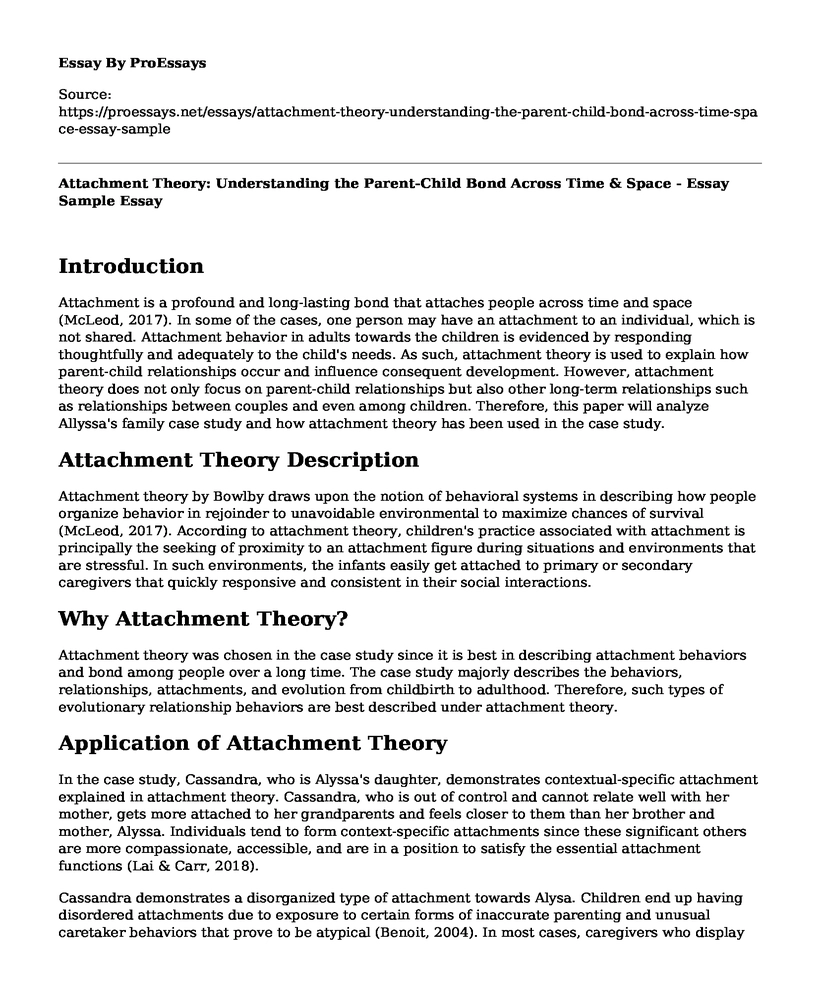Introduction
Attachment is a profound and long-lasting bond that attaches people across time and space (McLeod, 2017). In some of the cases, one person may have an attachment to an individual, which is not shared. Attachment behavior in adults towards the children is evidenced by responding thoughtfully and adequately to the child's needs. As such, attachment theory is used to explain how parent-child relationships occur and influence consequent development. However, attachment theory does not only focus on parent-child relationships but also other long-term relationships such as relationships between couples and even among children. Therefore, this paper will analyze Allyssa's family case study and how attachment theory has been used in the case study.
Attachment Theory Description
Attachment theory by Bowlby draws upon the notion of behavioral systems in describing how people organize behavior in rejoinder to unavoidable environmental to maximize chances of survival (McLeod, 2017). According to attachment theory, children's practice associated with attachment is principally the seeking of proximity to an attachment figure during situations and environments that are stressful. In such environments, the infants easily get attached to primary or secondary caregivers that quickly responsive and consistent in their social interactions.
Why Attachment Theory?
Attachment theory was chosen in the case study since it is best in describing attachment behaviors and bond among people over a long time. The case study majorly describes the behaviors, relationships, attachments, and evolution from childbirth to adulthood. Therefore, such types of evolutionary relationship behaviors are best described under attachment theory.
Application of Attachment Theory
In the case study, Cassandra, who is Alyssa's daughter, demonstrates contextual-specific attachment explained in attachment theory. Cassandra, who is out of control and cannot relate well with her mother, gets more attached to her grandparents and feels closer to them than her brother and mother, Alyssa. Individuals tend to form context-specific attachments since these significant others are more compassionate, accessible, and are in a position to satisfy the essential attachment functions (Lai & Carr, 2018).
Cassandra demonstrates a disorganized type of attachment towards Alysa. Children end up having disordered attachments due to exposure to certain forms of inaccurate parenting and unusual caretaker behaviors that prove to be atypical (Benoit, 2004). In most cases, caregivers who display atypical behaviors possess a history of unresolved emotional and physical trauma (Benoit, 2004). Alysa suffered cerebral palsy since she was a kid. Although she received all the love from the parents, she frequently feels emotionally traumatized about it. She ends questioning her parenting skills, especially when her parents cannot let her discipline, Cassandra. Alyssa resents her historical lack of autonomy, which majorly affects her parenting towards her daughter. It might as well impact her breakup with Alyssa’s father before he died. Additionally, Alyssa and Cassandra get physical, verbal, and emotional abuse from Mark, who has also demonstrated partisan parenting by hating Cassandra and loving his son. All these incidences have contributed to the disorganized attachment depicted by Cassandra and her “out-of-control” behavior that has also led to nights of alcohol drinking and sexual involvement.
Alyssa’s parents have depicted a secure kind of attachment towards Alyssa despite her cerebral palsy condition. The parents ensured to get her best medical service for her health while her mother devoted all her life to taking good care of Alyssa. Caregivers or parents who are securely attached to their kids respond more quickly to their children's needs, are loving to their kids, and do all they can to build trust and lasting relationships with their children (Benoit, 2004). It was very evident with Alyssa's parents, especially her mother. However, Alyssa seemed to have insecure attachment towards the parents. It is evidenced by the fact that Alyssa resents her mother's commitment to her condition. She resents her mother's action, which should not be the case. In the case study, it has, therefore, resulted in a secure-insecure kind of attachment between Alyssa's mother and Alyssa.
Both Mark and Alyssa demonstrated an insecure attachment, which majorly affected Oscar's and Cassandra's attachment. It is evident that in cases where parents or caregivers possess dangerous and unhealthy attachments, the children are likely to maintain the same kind of attachment or, in extreme cases, insecure-avoidant attachments (Lai & Carr, 2018). Mark and Alyssa are involved in frequent emotional, physical, and verbal fights, which results in their divorce, and Alyssa moves out with the two kids. As a result, Oscar resents Cassandra and can't stand others because she broke up her parents. Conversely, Cassandra hates Oscar and can't stand her for her moment, which prompts her to stay out of the house. The children have avoidant attachment characteristics.
Conclusion
Different attachments in families, as depicted in the case study, are determined one's ways of interactions and behaviors in relationships, unresolved emotional and physical trauma, and histories of neglect or suffering. Therefore, parents ought to provide healthy relationships and environments to establish the right attachments with their children.
References
Benoit, D. (2004). infant-parent attachment: Definition, Types, antecedents, measurement, and outcome. Paediatrics & child health, 9(8), 541-545.
Lai, Y. H. & Carr, S. (2018). A critical exploration of child-parent attachment as a contextual construct. Behavioral Sciences, 8(12), 112.
McLeod, S. (2017, February 05). Attachment Theory. Simply Psychology. https://www.simplypsychology.org/attachment.html
Cite this page
Attachment Theory: Understanding the Parent-Child Bond Across Time & Space - Essay Sample. (2023, Aug 17). Retrieved from https://proessays.net/essays/attachment-theory-understanding-the-parent-child-bond-across-time-space-essay-sample
If you are the original author of this essay and no longer wish to have it published on the ProEssays website, please click below to request its removal:
- Essay Sample on Effective Interpersonal Communications
- Essay Sample on Race Reporting
- Essay Sample on Disparities Among the Minority and Criminal Justice
- Societal Factors Influencing Dispute Processing Preferences - Essay Sample
- Essay Example on Cyberbullying in High Schools: Devastating Effects and Prevention
- Paper Example on Doctors & Patients: Meeting Challenges in Treatment through Technology
- Essay Sample on Parenting Styles and Child Outcome







